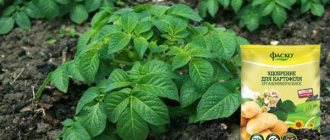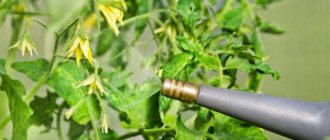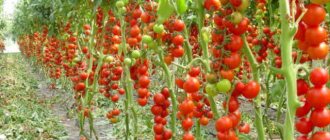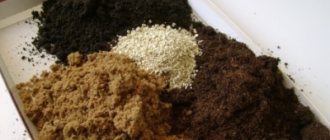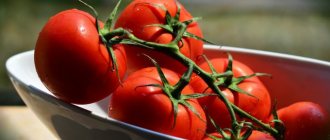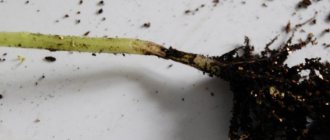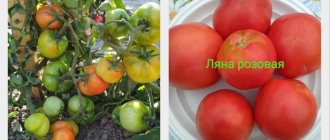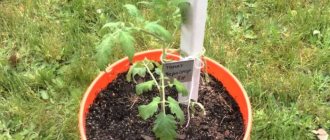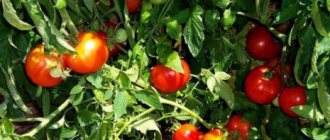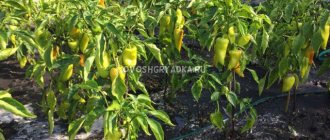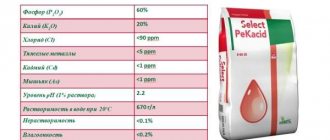Why do tomato seedlings need feeding?
Fertilizing is extremely important at the stage of growing seedlings - the strength of the plants and their subsequent development depend on the fertility of the soil.
Tomato seedlings need feeding for:
- high immunity to diseases;
- ability to tolerate transplantation well;
- ability to withstand external factors after transplantation to a permanent place - in open ground or under film cover;
- obtaining large and tasty fruits;
- for high productivity.
Gardeners often make the mistake of concentrating on watering and disinfecting the soil, and do not feed the seedlings on time. Seedlings need to constantly replenish the energy spent on growth. Moreover, every day the “appetites” of the growing young animals are growing.
After landing
In the period from 3 to 5 days after planting the growing bushes in the greenhouse (usually the first days of June), they need to be fed with complex fertilizer, which contains:
- phosphorus;
- nitrogen;
- potassium.
At the same time, the main thing is not to overdo it with nitrogen, since the leaves will grow too actively, and on the contrary, there will be fewer fruits.
The climate in the greenhouse is more humid than in open ground, so the plants will absorb nutrients very quickly.
To ensure that microelements have time to be absorbed, it is better to reduce the concentration of fertilizers . This option is most optimal: 3 tsp. dilute nitrophoska, half a liter of mullein in 9 liters of water, pour 1 liter of fertilizer under the root of each bush.
How to determine what substances tomato seedlings need?
To grow, seedlings definitely need nitrogen, phosphorus and potassium. In smaller quantities - other microelements.
The main fertilizers for tomato seedlings and their effect:
| Fertilizer | Effect |
| Nitrogen | Wide and strong foliage |
| Phosphorus | Active flowering and high immunity |
| Potassium | Enhanced root development |
Vegetable growers can determine from one type of plant what elements it lacks.
Signs of nutritional deficiencies and how to eliminate them:
- Nitrogen. Excessive elongation of seedlings, especially aggravated by insufficient lighting. Leaves turning pale. Nitrogen deficiency is eliminated by adding urea or nitroammophosphate. Subsequently, in open ground, the deficit can be compensated by adding mullein, bird droppings and green fertilizers.
- Potassium. Curly hair on the top of the head is a clear sign of potassium starvation. The shortage is compensated for by adding potassium sulfate or wood ash.
- Phosphorus. The leaves are curled and have a purple tint. Shedding of flowers and ovaries. Add wood ash and superphosphate.
- Iron. Yellowing of leaves, veins remain green. Iron deficiency causes a condition called chlorosis. Add iron preparations to the soil – “Aquamix”, etc.
- Calcium. The leaves are deformed and have yellow spots on the green background. You can make up for the deficiency with wood ash, eggshells, and bird droppings.
- Magnesium. Brown spots appear on the leaves, and the stems become brittle. Wood ash, slurry, and magnesium help correct the situation.
- Manganese and copper. Plants often get sick and grow slowly. Special copper-containing preparations and potassium permanganate are added.
Identifying Signs of Nutrient Excess
Phosphorus and potassium from the soil are quite difficult to absorb by plants, so plants rarely suffer from their excess.
Nitrogen is absorbed quickly from both organic and mineral fertilizers, so uncontrolled use can lead to oversaturation. Whether feeding is necessary can be easily determined by appearance. Excess nitrogen is immediately noticeable: the thick stem, large, curling leaves, reminiscent of crumpled paper, are very fragile. Poor formation of flower clusters and ovaries. The plants are intensively growing green mass, but there are no ovaries. In this case, it’s worth thinking about how to feed the tomato seedlings so as not to harm them further.
Advice! You can help the plant use excess nitrogen faster by increasing the amount of potassium, phosphorus and wood ash in the fertilizing.
The microelements contained in the ash contribute to faster nitrogen processing. Some of the excess nitrogen can be washed out by careful watering, but you should not allow it to overflow.
Rules for feeding tomato seedlings
In a limited amount of land, it is impossible to collect the full supply of macro- and microelements necessary for the growth of tomato seedlings. Therefore, fertilizing has to be done regularly - as the seedlings grow.
Rules for feeding tomato seedlings:
- The water from which nutrient solutions are prepared must be warm and settled.
- Water over moist soil to avoid burning the roots.
- Foliar feeding - spraying, is carried out in the absence of direct sunlight, so as not to provoke leaf burns.
- It is better to apply fertilizers in the morning. Evening feeding often causes fungal diseases.
- To ensure that fertilizers are as effective as possible, tomatoes are sown for seedlings in loose soil. If necessary, it can be carefully loosened.
When feeding tomato seedlings, it is necessary to take into account the features of applying various types of fertilizers:
- Liquid. Delivers nutrients well. Liquid fertilizer is diluted in a certain amount of water. The resulting solution is used to water the soil or spray the seedlings.
- Dry. First, it is dissolved in water and then applied to the soil. If you scatter dry granules over seedling boxes, the fertilizer will not be absorbed by the plants. In dry form, granules are applied only in greenhouses and open ground.
When choosing between organic and mineral fertilizers, they take into account the condition of the seedlings - their appearance, size, need for a specific element.
Types of fertilizers
Fertilizer for tomato seedlings can be supplied to the plant in various ways:
- Dry powders, granules, crystals. The method is used for the main filling of soils and seedling mixtures.
- Fertilizer solutions by watering. Most fertilizing to introduce the NPK complex is carried out in this way.
- Foliar feeding of tomato seedlings by finely spraying with a spray bottle or special sprayers.
Feeding tomato seedlings at home
Feeding seedlings cannot be carried out haphazardly. Fertilizers are applied at a certain time using a special composition.
First feeding after germination
The first feeding is carried out at the stage of formation of the second true leaf. Preference is given to weak nitrogen-containing compounds.
The nutrition of the sprout begins from the moment the first root appears - it is time to apply fertilizer. But you cannot feed seedlings at the cotyledon leaf stage; the seedlings are still very weak and feeding will most likely cause damage.
If a substrate was used instead of soil, then the first fertilizing is carried out after picking. The purchased mixture contains a complete “set” of nutrients, and the application of fertilizers can be postponed.
If the soil mixture is homemade, then fertilizers are applied approximately 2 weeks after emergence. The first fertilizing should fill the soil with three main elements - nitrogen, phosphorus, potassium.
For feeding you can use the following composition:
- potassium sulfate – 1/2 tsp;
- urea – 10 granules;
- superphosphate – 1.5 tsp;
- water – 3 l.
This option would also work:
- superphosphate – 1 tbsp. l.;
- ammonium nitrate – 1 tsp;
- potassium sulfate – 1 tbsp. l.;
- water – 5 l.
For the first feeding, you can use complex fertilizers, for example, Agromax, Agricola and similar compounds.
Thanks to the first feeding, tomato seedlings take root well and survive safely after picking.
An interval of 4-5 days is maintained between fertilizing and picking.
Second feeding after picking
The second feeding (for seedlings grown in the substrate - the first) is carried out 10-14 days after picking. At this stage, complex fertilizers containing a small dose of fungicides are applied.
Recommended fertilizers:
- Nitrophoska – 15 g per 1 liter of water;
- Agricola – 25 g per 10 liters of water;
- Strong – 10 g per 10 l;
- Sodium humate – 250 ml per 5 l;
- Effecton – 1 tbsp. l per 1 l.
You can prepare the composition yourself from:
- calcium nitrate – 2 tsp;
- sifted ash – 1/2 cup;
- water – 5 l.
If the seedlings are stretched excessively, you need to quickly add superphosphate. The solution is prepared by mixing 3 tbsp. l. substances with 3 liters of warm water.
Third feeding before planting in the ground
The third feeding is carried out 2 weeks before transplanting into open ground, if the need arises.
Fertilizers for the third feeding:
- Nitrophoska – 1 tbsp. l. for 10 l;
- A mixture of double superphosphate - 4 g, potassium salts - 8 g, urea - 1 g is diluted in 1 liter of water.
During the third feeding, a lack of elements is diagnosed by appearance. If necessary, add the appropriate element.
The third feeding is often carried out not at the root, but by spraying on the leaf. If the deficiency of elements is small, chemical preparations are replaced with natural ones.
Fourth feeding after planting in the ground
This is the last feeding of the seedlings, it can be the third in a row if the seedlings did not have to be fed before due to a lack of elements.
Recommended fertilizers per 5 liters of water:
- superphosphate – 1 tbsp. l.;
- potassium sulfate – 1 tbsp. l.;
- ammonium nitrate - 1 tbsp. l.
The resulting mixture is watered at the roots of the seedlings. Or they use a complex fertilizer, for example Kemira.
Feeding tomatoes after picking
First you need to decide what kind of connection they are missing. And only then begin the procedure.
The appearance of young vegetables will indicate this:
- If, after diving, tomato seedlings have slowed down, then the best option is to use leaf humus or sodium humate.
- Increased fragility of the stem, when shoots break at the slightest touch, is provoked by a deficiency of calcium and magnesium. In this case, you need to feed with chalk or eggshells.
- Pale leaf color most often appears in plants that lack iron. Mineral preparations are needed.
- If the foliage has a purple tint, then the tomatoes are low in fluoride. They can be watered with fluoridated drinking water or eggshell infusion.
- When the foliage turns yellow and begins to wilt, this is a sign of low nitrogen content. This is the main biogenic element for plants; without it, the growth and development of seedlings is impossible. It is good to feed the plants with a solution of wood ash.
If, due to unbalanced application of fertilizers, the above-ground part of the tomato develops too actively, and the roots lag behind, then superphosphate fertilizers should come to the rescue. They will accelerate the growth of the vegetable rhizome so that the stem and leaves can receive sufficient nutrients. Also, from store-bought products for feeding after diving, urea, potassium sulfate, and you can use saltpeter.
Mineral fertilizers for tomato seedlings
These fertilizers are highly effective and bring great benefits to tomato seedlings. But the correct dosages must be observed.
Nitrophoska
Nitrophoska is recommended for weak seedlings. Nitrophoska is added approximately 5-7 days after picking, in the form of a solution. For 1 liter of water take 15 g of nitrophoska. This volume is enough for about 50 seedlings.
Next time, the seedlings are fed with nitrophoska during transplantation into the ground. It is important to mix the granules with moist soil so as not to burn the roots.
Agricola
The drug contains phosphorus (20%), nitrogen (15%) and potassium (25%). The preparation contains iron, boron, magnesium, and manganese in small quantities. The purpose of "Agricola" is to strengthen seedlings, activate their growth and development.
2.5 g of fertilizer is diluted in 1 liter of water. Water the seedlings at the roots. Not suitable for foliar spraying. Agricola can be used only 2 weeks after the pick.
Effecton
Belongs to the group of organic fertilizers and effectively stimulates the growth of seedlings. Fertilizer is obtained by composting peat and adding wood ash or dolomite flour, potassium chloride, and phosphate rock to it. The composition of "Effecton" is similar to manure.
To obtain a solution, dilute 3 tbsp in 10 liters of water. l. facilities. The composition is applied at the root or used to spray seedlings.
If Effekton is used to feed seedlings, then no other fertilizers are used.
Athlete
The drug regulates growth. It slows down the growth of seedlings, making them stronger by stimulating root growth:
- While using Athlete, watering is stopped. After 1-2 days, the soil is sprayed with a spray bottle for better effect.
- If the seedlings are stretched, “Athlet” is applied 4 times with an interval of 5 days. Treatment is stopped a week before planting seedlings in the ground.
- Start using the drug after the formation of three true leaves.
Urea
Replenishing nitrogen deficiency leads to an increase in green mass and strengthening of stems. When fertilizing seedlings, it is applied in liquid form. It is recommended to water before adding to the soil. 20-30 g of urea are dissolved in 10 liters of water. The concentrated solution should not get on the leaves - it can cause burns.
Foliar feeding is possible - they are more effective than applying at the root. Spray a solution prepared at the rate of 15 g per 3 liters of water. Spray the plants in the early morning or evening.
To accelerate the growth of seedlings, before sowing, add 2 g of urea to each box.
How to feed tomatoes: tomato growth regulators
From the time the first sprouts appear in the pots until they are moved to the greenhouse or garden, it usually takes 1.5-2 months.
During this growing season, the seedlings need to be fed; this is done 4 times according to the following scheme:
- as soon as 2 or 3 true leaves appear;
- 10 days after the first procedure;
- again after 10-12 days;
- 7-10 days before planting in the garden.
Important! The amount of fertilizing and the quality of watering directly affect the abundance of the harvest.
To stimulate the growth of tomatoes, you can use various preparations that are sold in gardening stores. Watering them with growth stimulants also has a good effect on tomato seedlings.
Athlete
This drug belongs to the group of biostimulants. When used correctly it will give good results.
It has the following positive influence:
- activates the growth of tomato seedlings;
- increases immunity;
- makes a thin trunk thicker and stronger;
- stimulates plant branching.
Atlet is used for tomatoes twice during their growing season. First, when 3 or 4 true leaves bloom, and then after 7-10 days. This will make the plants even stronger.
Mortar
The solution is available in powder form. It is good to use in cases where the stem and leaves of tomatoes are very faded and stop growing. The product also helps if the seedlings were planted in poor, low-nutrient soil. To prepare the solution, use well-settled water; it is better to let it sit for 24 hours. For each liter add a gram of powder. The solution is applied at intervals of 7 or 10 days.
The good thing about the solution is that this preparation can be used both for root feeding and for spraying the above-ground parts of young tomatoes. Seedlings noticeably thicken their stems after the first treatment with this product.
Nitrophoska
The time-tested fertilizer is produced in the form of granules. Nitrophoska is a source of both phosphorus, nitrogen and potassium. Due to this complex composition, nitrophoska enhances the growth of seedlings after pruning. After applying the mixture, the tomato stems noticeably thicken after 10-12 days.
When using nitrophoska:
- The root system of picked seedlings develops well;
- plants branch well;
- the level of fruit formation increases.
It is preferable to feed tomatoes in the morning. For the first feeding, it is better to prepare a weaker solution of the drug than indicated in the instructions (about 2 times). The second application can be carried out at the recommended dosage.
Important! Fortified seedlings produce a harvest with high taste.
Agricola
This product has various forms of release. It can be purchased as granules or liquid. There are also special sticks that can be stuck directly into pots with seedlings. Agricola is a complex preparation; it contains a large list of micro- and macroelements.
Due to this means:
- increases the resistance of tomatoes to various diseases;
- makes shoots more durable;
- tomatoes grow correctly;
- a lot of ovary is formed on them.
To feed tomato seedlings, prepare a solution in a ratio of 1:200. When planting in beds - in a ratio of 1:100. Tomatoes should choose the product labeled No. 3. After the plants have been fed with Agricola, the next application of fertilizers can be carried out after 10-15 days.
Organic fertilizers
All organic fertilizers are environmentally friendly and effective. The main thing in their use is timeliness and correct dosage. They are added at the initial stage of growing seedlings, as they contain a lot of nitrogen - it stimulates the growth of green mass.
Compost
Used at the beginning of the growing season to enhance the growth of the aboveground part. Prepared from manure or plants. Infusions are diluted in water 1:10. If the fertilizer is based on bird droppings, it is diluted in a ratio of 1:15.
Vermicompost
This is industrial organic matter. In Biohumus, the seed is kept and the seedlings are fertilized for active growth. The solution is prepared by mixing the drug and water 1:20. Water to the roots.
Mullein
Mullein stimulates the growth of seedlings and promotes their strength. A fermented composition is used. Pour 10 kg of mullein into a bucket of water. Insist for a day in a warm place. Mullein is applied for the first time 2 weeks after planting the plants in the ground.
How many times per season should you feed?
Since orderliness when applying fertilizers is very important, there is a special scheme for fertilizing tomatoes. In general, it represents five main stages that are inextricably linked with the stages of tomato development.
When planting in the ground
By the time the tomatoes are planted, the planting site must be prepared and filled with organic and mineral fertilizers. It is impossible to achieve high yields of this crop on poor and depleted lands.
For good survival and further development of tomatoes, the NKP complex - nitrogen-, potassium- and phosphorus-containing fertilizers - must be added to the soil. If you neglect to enrich the soil composition, seedlings will develop slowly, may begin to get sick, and produce low yields.
Two weeks after landing
During this period, young tomato bushes that have already adapted to new conditions need increased nutrition for growth and development. They need a balanced feed containing three main elements: nitrogen, phosphorus and potassium, as well as microelements. Some gardeners fertilize earlier - already 1 - 1.5 weeks after planting.
During the period of growth
During the period of active growth, tomato bushes need fertilizing with nitrogen and phosphorus.
The interaction of these two elements ensures the proper development of tomatoes.
The supply of phosphorus in the required volume stimulates the accelerated development of the root system, and a sufficient amount of nitrogen in the soil helps the bushes gain green mass in a short time.
During flowering
Tomato bushes begin to bloom approximately 1.5 - 2 months after planting seedlings in open ground, and in greenhouse conditions these periods begin a little earlier. Almost all feeding of tomatoes during flowering is aimed at fruit set. In case of deficiency of potassium and phosphorus nutrition, flowers may fall from the bushes without having time to pollinate. As a result, tomato yields will drop sharply. During this period, it is recommended to avoid the application of fertilizers with a high nitrogen content.
During fruit set
At this time, plants especially need potassium and phosphorus, but fertilizers with a high nitrogen content should be abandoned. There are many complex preparations that can be used during this period, but organic supplements remain the safest.
Natural remedies
The advantage of natural remedies is safety. Most fertilizers are prepared from available materials that can be found in every household.
Hydrogen peroxide
To stimulate growth, seedlings are watered with a solution of hydrogen peroxide. It is obtained by mixing 1 tbsp. l. drug with 1 liter of warm water. The resulting solution is used as foliar feeding.
The prepared solution can be applied at the root to combat root rot, but after its use small roots die.
The frequency of spraying is determined individually. Spruce seedlings are in good condition - the leaves are large, and the stems are strong and thick; it is enough to apply a peroxide solution once every 10 days.
A solution of hydrogen peroxide is an effective disinfectant; it is used to treat the soil poured into seedling boxes.
Ash
Wood ash is one of the most popular fertilizers among gardeners. It contains many microelements, is a powerful preventive agent, and has a protective effect.
Before use, the ash is diluted in water. The aqueous solution is applied to the root in pure form, or mixed with herbal infusion.
Ash is also used in dry form. Moreover, it acts not only as a fertilizer, but also repels pests, and most importantly, prevents blackleg - the most dangerous disease for seedlings.
Boric acid
Boric acid contains boron. This microelement is necessary for seedlings to grow normally; it:
- enhances metabolism;
- activates the growth of roots and green mass;
- increases the amount of chlorophyll.
Prepare the fertilizer by diluting 1 g of the product in a glass of hot water. Next, the glass with the solution is diluted in 1 liter of water. Mix thoroughly and water the resulting solution at the root of the seedlings.
A solution of boric acid can be used for foliar feeding. The leaves of the seedlings actively absorb the necessary microelements.
Yeast
This affordable product is a source of microelements necessary for the rapid growth of strong tomato seedlings. Seedlings with such fertilizing will grow by leaps and bounds.
Preparation of yeast dressing:
- 10 g of dry yeast are dissolved in 1 liter of water.
- Add 1 tbsp. l. Sahara.
- When the solution rises, dissolve it in one bucket of water.
Water at the root. The solution must be used within 24 hours.
Other recipes for yeast feeding for seedlings are given here.
Iodine
Iodine supplements have a multifaceted effect, they:
- stimulate the growth of green mass;
- have a beneficial effect on the process of fruit ripening and improve their quality;
- have a bactericidal effect;
- increase the immunity of seedlings;
- increase the yield of tomatoes.
The fertilizer is prepared by dissolving 10 drops of iodine in 10 liters of water. The solution is applied at the root.
Egg shells
Eggshells are useful for thin seedlings. It is rich in calcium carbonate, phosphorus, silicon, magnesium, potassium. Plants gain strength, become stronger, “stockier”. The shells are first kept in water for 3 days.
Onion peel
Onion peels contain many nutrients; they contain carotene, phytoncides, vitamins B and PP. Husk infusion can replace water with each watering or from time to time.
How to prepare the solution:
- Take a couple of handfuls of onion peels and pour 1 liter of hot water.
- Let it sit for 24 hours.
Water the seedlings at the root with an undiluted solution.
Milk
Milk contains potassium, copper, calcium, iron, phosphorus and other trace elements. Improves photosynthesis, increases the effect of organic fertilizers.
A nutritious and disinfecting mixture is prepared from milk by mixing the following components:
- milk – 1 glass;
- iodine – 5 drops;
- water – 1 l.
Potassium permanganate
Potassium permanganate solution is a source of manganese and potassium. The solution is usually applied as foliar feeding. Potassium permanganate is often mixed with manure or wood ash. It is not only a top dressing, but also an antiseptic.
Seedlings are fed with potassium permanganate twice. The solution is prepared by mixing 10 liters of water with 5 g of powder. The frequency of application is once every 10 days.
Coffee grounds
It nourishes and strengthens seedlings, and also makes the substrate looser - this promotes root development. The grounds are simply added to the soil, and to prevent the soil from acidifying, ash is added at the same time.
Nettle infusion
To prepare the fertilizer, take fresh, just cut nettles. The tops are chopped and filled with water - 2:1. Cover the container with the infusion with a lid and place in a warm place.
After 7-10 days of infusion, the fermented nettle infusion is diluted with water (1:10). Plants are watered with this solution at the root.
Traditional methods
Many gardeners prefer to feed vegetables exclusively with natural means. They are affordable, and many are waste.
The most common natural remedies for tomatoes are:
- Manure. This option is useful only to those who have their own private farm. You need to take 3 volumes of water and 1 part of manure, mix well and leave for a day. This infusion can be watered no more than once every 14 days. They bring it under each bush.
- Bird droppings. This organic fertilizer is also suitable for those who grow crops in large quantities in a country house (greenhouse). The litter consumption rate is 0.2 kg dry or 0.5 kg wet per square meter.
- Yeast. This method can be practiced in an apartment, but the smell is also not the most pleasant. You will need fresh compressed yeast at the rate of 10 g per bucket of water. They need to be crumbled and dissolved well in warm water. Watering with this solution is carried out 3 times during the entire growing season.
- Iodine. This feeding should be done once every 14 days. For every liter of water add 1 drop of iodine. This solution should not get on the leaves, otherwise they will get burned.
- Wood ash. A time-tested remedy for tomato seedlings, which has not lost its popularity today. Its quantity is 1 tbsp. spoon for 2 liters of hot water. This mixture should be allowed to brew for a day and you can water the plants. It is needed so that the seedlings grow better.
- Egg shells. You need to use thoroughly washed shells; for one feeding it will be enough to take it from 2 or 3 eggs. After washing and drying, it is thoroughly crushed with a rolling pin. The powder is placed in a 3 liter jar, water is added to the top. Leave the fertilizer for 3 days, stir regularly. This mineral solution must be filtered and the volume brought to 9 liters with water.
- Bone meal is another source of minerals (calcium, phosphorus). For every square meter, about 3 kg of flour is consumed. You can water the solution, but it will have to be prepared in advance. To do this, pour 1 kg of bone meal into a bucket of hot water. Leave the solution for a week, then filter. For irrigation, it is additionally diluted with water in a ratio of 1:10. This feeding can be done only once a month.
- Onion peel. It will take 40 g for a bucket of water. All you need is to simply fill the husk with water, maybe warm, and leave it to infuse for up to 5 days. This mixture is not only a source of important elements, but also an excellent disinfectant.
- Nettle. This weed is an excellent natural fertilizer. A bunch of fresh grass is placed in a bucket of water and left for a couple of days. The solution should be light yellowish in color. If it turns out too concentrated, then dilute it with water.
- Coffee grounds. It is applied to the soil directly when planting seedlings. To obtain this fertilizer, the dried coffee is washed well with water and dried. Ground coffee is not only a source of nitrogen, but also a good leavening agent.
- Banana skins. They can be used in a variety of forms, for example, infused in water. To do this, 3-4 skins are cut and filled with water in a 3 liter jar. After a few days, the infusion is filtered and diluted with water in a 1:1 ratio. But it is much more convenient in winter to dry them cut up on a radiator and grind them using a coffee grinder. When planting in the soil or when loosening it, add banana powder in small portions.
- Kefir. To do this, pour 1 liter of fermented milk drink per liter of water and water the tomatoes at the root in the morning. Water no more than once every 2 weeks.
All of these “homemade” fertilizers can be alternated with each other or with ready-made mineral fertilizers so that young plants receive all the necessary nutrients. Fertilizers must be applied in the morning or evening, always in combination with watering. Fertilizers should be applied at the prescribed time or if the appearance of the seedlings is unsatisfactory: they are weak. However, we must not forget that too much fertilizer is also bad. It is also good to add peat to the soil. Although it is not a fertilizer as such, it loosens the soil.
Useful tips
Experienced vegetable growers advise:
- Excess nutrition can cause an increase in green mass and elongation of the stem. In this case, the seedlings must be moved to a place with lower temperature and lighting.
- Banana peels can be used as a top dressing - this is a good source of potassium. The infusion is made by pouring 3 liters of water over the peels of three bananas. After three days, the infusion is ready - you can water the seedlings.
- Fertilizing will be much more effective if you regularly loosen the soil near the plants.
Growing tomato seedlings requires maximum attention from the gardener; it is important not only to fertilize on time, but also to correctly “make a diagnosis.” The future harvest depends on the timeliness of fertilizing, the correct choice and dosage.
How to feed bushes?
There are 2 options for applying fertilizers: at the root and foliar method (irrigation). The first has a long-lasting effect, helping to pass beneficial substances through the root system to all parts of the plant.
Irrigation is more of an auxiliary method, which makes it possible to help tomatoes get a life-giving vitamin cocktail twice as fast.
But there is a nuance: foliar feeding does not nourish the roots, its effectiveness is short-term.
Under the root
Watering fertilizer mixtures at the root helps tomatoes receive microelements and pass them through all parts. Including leaf blades, ovaries, crown. But root feeding can harm tomatoes. Therefore, compliance with all safety standards is required:
- avoid contact with the green part;
- dilute according to instructions/recommendations;
- do not use expired goods;
- carry out additional watering before application.
The effect is obtained after 5-10 days. Reason: beneficial substances “travel” through the plant for a long time, but are preserved for a long time, remaining in the roots for a long time.
Foliar fertilizer
There are many nuances when using foliar application of fertilizer mixtures. First: the need to purchase different types of sprayers, since dilution products have a different structure and consistency.
The second is that tomatoes absorb microelements and nutrients through leaf plates. The effect is obtained faster than from root feeding a tomato.
But the result is short-lived. After spraying, the substances are easily washed off by rain. Therefore, alternate application of fertilizers in different ways will be required.
Tips and tricks from experienced gardeners
In addition to selecting fertilizer mixtures, it is recommended to take into account the type of soil and where the tomatoes are grown. Several soil compositions occur in one area. Therefore, before starting work, an analysis is done.
Applications, regardless of the stage of development of tomatoes, should be carried out in the evening or early in the morning. It is best in cloudy weather, but without rain or other adverse weather conditions.
The latest recommendation from experts: you can reap a rich harvest if you take into account the characteristics and requirements of the tomato variety.
From germination to picking
The structure of the seed is such that from the sprout pipping until the stage when the first pair of real carved tomato leaves spreads over the cotyledons, there is enough nutrients. They are laid during the ripening period of future planting material and are stored until the seed awakens.
Breaking through the shell, through the soil that separates it from sunlight, the sprout is rich in vitamins, macro-, and microelements. It contains the entire periodic table. That is why it is so useful to eat sprouts, especially in the spring, during the period of vitamin deficiency. Knowing about the rich composition of the seed, gardeners safely sow vegetable crops in substrates devoid of any nutritional value:
- coconut crumbs;
- peat tablets;
- for toilet paper - according to the Moscow method.
But, having first blossomed the dense, rounded cotyledon leaves, and then the real ones, the tomato bush uses up its food supply completely. For further growth, seedlings need new sources of energy. Otherwise, harmonious development slows down: small bushes stretch out, become thin, leaves become small and pale. If starvation continues, the seedlings will die.
What a gardener should do at this time depends on the method of growing seedlings.
Traditional cultivation in substrate
Gardeners, who in the old fashioned way sow tomatoes for seedlings in boxes, containers - common containers, know: the time has come to plant the seedlings in separate pots. It turns out that the tomato simultaneously receives:
- larger volume of land;
- spacious seating;
- fresh nutritious soil flavored with vermicompost.
It turns out that no bait is required before picking. If the transplant takes place on time. If the deadlines are missed, the gardener will have to disturb plants that are slightly overgrown and already weakened by nutritional deficiency. There is no point in applying fertilizers before diving. It is more useful to spray the bushes with Epin or another stimulant antidepressant. Anti-stress remedies help tomatoes cope more easily with unusual situations.
It is good for tomatoes that are sown and grow before planting in a substrate rich in nutrients. They are dropped into the same fertilized soil. To ensure that the sprouts look strong, juicy, and do not lighten or stretch, you need to buy soil or prepare it yourself.
Store-bought soils for tomato seedlings are made on the basis of both types of peat - top and bottom peat, vermicompost. Add vermiculite with sand. There are substrates that are universal or designed specifically for tomatoes, peppers and eggplants. The most popular name is “Krepysh”, which produces. “Baby” from the same manufacturer - especially for tomatoes. Popular substrates are “BioMaster” and “Bogatyr” - a whole series.
If a gardener prepares the soil on his own, he takes:
- garden soil from cucumbers or zucchini, carrots or onions, cabbage;
- adds a third of compost and humus;
- generously sprinkles with wood ash;
- adds sand with vermiculite.
As a result, the soil turns out to be rich in composition and loose in structure.
In any case, the soil is treated thermally, using potassium permanganate or Fitosporin to avoid treating seedlings from infection or pests.
Alternative methods of growing seedlings
Tomatoes growing completely without soil (Moscow style) are planted in a nutritious soil mixture. In narrow bundles, seedlings fight for space and light, so they often turn out thin and long. The advantage of the method is a minimum of trauma to the root system. The central rod often grows longer than the bush. Rolled tomatoes do not touch neighboring roots. Gardeners know that when transplanting tomatoes, it is better to place them as deep as possible. New roots will appear on the stem on all sides, drawing nutrients and water from the soil.
By the stage of the third true leaf, coconut or peat tablets have exhausted their initial resources. A limited amount of substrate causes growth to slow down. The seedlings in the tablet are transferred to a nutrient substrate. The bushes receive an incentive for further development.
Saving space on the window, seedlings are grown on a minimum of soil - in snails or diapers. More often in this form, tomatoes survive until they are planted in the garden. But without nutrition, the plants will either become completely skinny, hopeless, or die. Therefore, instead of picking, the first feeding is carried out.
Recipes for first feedings
At this stage, seedlings are given a maximum of nitrogen - the main building macroelement. Source – any ammonia preparation:
- saltpeter – 2.5 g, diluted in 5 liters of settled water;
- urea – 10 g for the same volume;
- mullein or bird droppings (for city residents, products are available in country stores, and for gardeners who keep livestock and poultry, fertilizer is always at hand);
- ammonia - 5 ml per liter bottle with a sprayer for irrigating seedlings.
Purchased organic matter is diluted according to the instructions included with the preparation. Homemade infusions are diluted with water 1:10 (mullein) and 1:20 (chicken droppings).
Manufacturers of fertilizers for early feeding of tomatoes produce products with a balanced composition:
- “Kemira” for the seedling period has “Combi” with three main macroelements and 11 microelements (for weekly watering). “Universal” is essentially a nitroammophoska, but at a higher level. “Lux” begins to work immediately after hitting the ground, but has a prolonged effect.
- Agricola offers both soil and fertilizers for the first stage of development of tomato seedlings. Suitable for seedlings are “No. 3”, “Forward”
- In the “Kristalon” series, “Special” is first used for tomato seedlings. “White” helps seedlings without additional lighting, and with “Blue” tomatoes are more comfortable under lamps. The manufacturer advises adding 2 g to each liter of water, without skipping fertilizing during the next watering.
- “Zdraven” – “Turbo” series. Universal, if you couldn’t find the target one - for tomatoes. Proportions – 1.5 g/1 liter.
Among the listed ways to feed tomatoes after the plants have begun to sprout, mineral, organic and improvised - folk - means of first feeding. The gardener, based on his personal strategy for cultivating the vegetable, selects suitable preparations.
